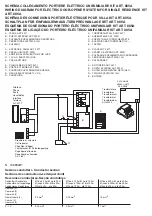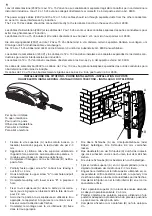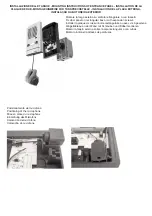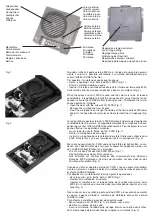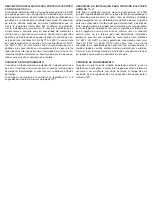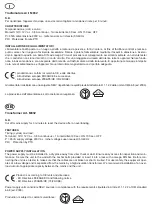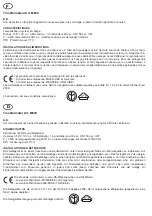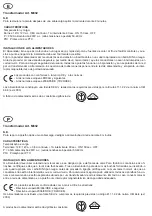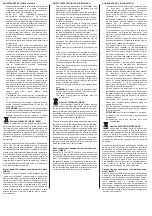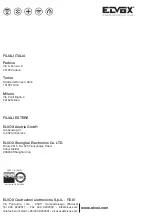
DESCRIZIONE IMPIANTO DI PORTIERE ELETTRICO UNIFI-
LARE "1+n"
Questo tipo di impianto si avvale del nuovo posto esterno Art.
930D che è in grado di generare una nota elettronica modulata
per la chiamata dal posto esterno: in questo caso i citofoni utiliz-
zati sono muniti di un altoparlante per la diffusione del suono. Il
collegamento complessivo si ottiene utilizzando un semplice tra -
sfor ma to re che alimenta l'intero impianto. Questo tipo di sistema
è particolarmente indicato per ristrutturazioni o conversioni di
impianti da semplice campanello a citofono in quanto il collega-
mento del montante si effettua con un solo filo comune più un filo
di ritorno per ogni apparecchio.
Gli impianti si possono realizzare senza segreto di conversazione
(con citofoni Art. 8877, Art. 6201) o con segreto di conversazione
(con citofoni Art. 8873, Art. 6201+7155): in quest'ultimo caso solo
l'utente chiamato è abilitato alla conversazione con il posto ester-
no e quindi tutti gli altri interni rimangono esclusi. Per un buon
funzionamento dell’impianto si consiglia di eseguire i collega-
menti come mostra lo schema di principio.
PRINCIPIO DI FUNZIONAMENTO
Quando un visitatore preme un pulsante della targa esterna si
sente nel citofono un segnale sonoro: l'utente interno può solle-
vare il microtelefono e conversare con il visitatore senza limiti di
tempo.
Il tempo di attivazione della serratura è regolabile da 1 a 4 sec-
ondi tramite l'apposito trimmer (P1).
SYSTEM DESCRIPTION OF "1+n WIRE" AUDIO DOOR
ENTRY SYSTEM
This type of unit makes use of the new external unit (Art. 930D)
which can generate a modulated electronic signal for a call from
the external unit; in this case, the door phones used are supplied
with a loudspeaker for the transmission of the sound. The overall
connections are made using a simple transformer which supplies
the whole system. This type of system is particularly suitable for
refurbishments or conversions of systems with a simple doorbell
with loudspeaker since connection of the unit is made with a sin-
gle shared cable plus a return cable for each unit. The systems
can be fitted without a conversation privacy function (with door
phones Art. Art. 8877, Art. 6201) or with a conversation privacy
function between the user and the person receiving the call (with
door phones Art. 8873, Art. 6201+7155). In this latter case, only
the user called can speak with the external unit, all the others
being excluded.
For a good installation operation it is advisable to carry out con-
nections according to the standard diagram.
OPERATING INSTRUCTIONS
When a visitor presses a button on the external plaque, he will
hear a sound on the phone; the user within the building can lift the
door phone and speak to the visitor without any time limit. The
period the lock is to be activated can be set at anything between
1 and 4 seconds using the special trimmer (P1).
DESCRIPTION INSTALLATION POUR PORTIER ÉLECTRIQUE
AVEC UN FIL "1+n"
Ce type d’installation est équipé du nouveau poste extérieur Art.
930D qui est en mesure d’émettre une note électronique modulée
pour l’appel depuis le poste extérieur: dans ce cas, les postes
d’appartement utilisés sont munis d’un haut-parleur pour la diffusion
du son. Le branchement général s’effectue en utilisant un simple
transformateur qui alimente toute l’installation. Ce type de système
est particulièrement indiqué pour les restructurations ou les conver-
sions d’installations de simples sonnettes à postes d’appartement,
car le branchement du montant s’effectue au moyen d’un seul fil
commun plus un fil de retour pour chaque appareil.
Les installations peuvent être réalisées sans secret de conversation
(avec des postes d’appartement Art. Art. 8877, Art. 6201) ou avec
secret de conversation entre deux utilisateurs (avec des postes
d’appartement Art. 8873, Art. 6201+7155): dans ce dernier cas, seul
l’utilisateur appelé est habilité à la conversation avec le poste
extérieur, les autres postes intérieurs étant par conséquent exclus.
Pour un bon fonctionnement de l’installation on conseille d’effectuer
les connexions selon le schéma de base.
PRINCIPE DE FONCTIONNEMENT
Lorsqu’un visiteur appuie sur une touche de la plaque extérieure, on
entend dans le poste un signal sonore : l’utilisateur intérieur peut
soulever le micro-combiné et converser avec le visiteur sans limite
de temps.
Le temps d’activation de la gâche est réglable entre 1 et 4 secondes
à l’aide du trimmer prévu à cet effet (P1).
BESCHREIBUNG DER ANLAGE FÜR “1+n DRAHT”
TÜRSPRECHANLAGE
Für diese Art Anlage wird die neue externe Sprechstelle verwendet,
die in der Lage ist, eine modulierte elektronische Note für den Ruf
von der externen Sprechstelle zu erzeugen: in diesem Fall sind die
verwendeten Haustelefonen mit einem Lautsprecher für die
Schalldiffusion ausgestattet.
Der Gesamtanschluß wird durch Verwendung eines einfachen
Transformators erzielt, der die ganze Anlage versorgt. Diese Art
System eignet sich insbesondere für Umbauten oder für die
Umwandlung einfacher Klingelanlagen in Sprechanlagen, da der
Anschluß der Anschlußsäule mit nur einer gemeinsamen Leitung
und einer Rückleitung pro Gerät erfolgt. Die Anlagen können ohne
Mithörsperre (mit Haustelefonen Art. Art. 8877, Art. 6201) oder mit
Mithörsperre (mit Haustelefonen Art. 8873, Art. 6201+7155) zwis-
chen den Teilnehmern realisiert werden: in letzterem Fall ist die
Konversation mit der externen Sprechstelle nur für den angerufenen
Teilnehmer möglich, und alle anderen Innenstellen bleiben daher
von der Konversation ausgeschlossen.
Für einen optimalen Installationbetrieb empfiehlt man die Anschlüße
nach den Prinzipschaltplan durchzufüren.
FUNKTIONSWEISE
Wenn ein Besucher auf einen Knopf des externen Klingeltableaus
drückt, ertönt im Haustelefon ein akustisches Signal; der interne
Teilnehmer kann den Hörer abnehmen und zeitlich unbegrenzt mit
dem Besucher sprechen. Die Aktivierungszeit der Sperre kann mit
einem Trimmer (P1) zwischen 1 und 4 Sekunden reguliert werden.
Summary of Contents for 8013406155801
Page 14: ...NOTE...
Page 15: ...NOTE...


